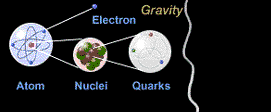|
POPULAR DESCRIPTION OF RESEARCH AREA
THE QUEST FOR A UNIFIED DESCRIPTION OF NATURE
Newtonian mechanics and electromagnetism as formulated by Maxwell in 1864 are
perhaps the two prime examples of unifying theories, that
is theories that explain large numbers of phenomena using just a few basic
assumptions and laws. In the twentieth century the ideas of unification was
further implemented with tremendous success in special and general
relativity, as well as in the Nobel prize winning work of Glashow,
Salam, and Weinberg on the electroweak interactions
relating within a common framework all electromagnetic and weak (eg all radioactive decays) phenomena.
The electroweak theory and the theory of strong interactions (forces acting
between the constituents of protons etc, the quarks) owe their success to the
fact that they work nicely as quantum theories. Quantum mechanics is the most
profound aspect of our understanding of nature in that it provides a
framework for how to approach phenomena at atomic scales or smaller. All
theories purporting to explain microscopic phenomena must adhere to the rules
of quantum mechanics. Quantum electrodynamics (QED), as well as the quantum
theories for weak and strong nuclear interactions are
examples of theories that work extremely well at these small scales. In
particular, this is true for QED whose agreement with experiments is better
than for any other theory known today.
The enigma of twentieth century physics has for decades been the clash
between quantum mechanics and general relativy, that is Einstein's theory of gravity. Seemingly unsurmountable problems appear as soon as one asks
questions at the Planck scale (10^(-35) meter), or
in the vicinity of black holes.
The most likely cure for these problems is the revision of Einstein's theory
that is built into the theory of superstrings. The basic idea is that when
approaching the Planck scale one discovers that the fundamental point like
building blocks used in ordinary quantum field theories are actually
different vibrational modes of an extended object,
a string. String theory has many interesting features; it unifies in one
single four dimensional quantum theory all known forces and elementary
particles, and in the process reduces the number of parameters that need to
be determined by experiments from between 20 and 30 (assuming massive
neutrinos) to one, not counting Planck's constant and the velocity of light.
The mathematically new structures that emerge from the string has also made an impact in pure mathematics. New
connections between different mathematical subdisciplines
and novel approaches to computing various quantities in for instance topology
has generated a new era of close interactions between physicists and
mathematicians. The common denominator in this context is the recent developments
in quantum field theory triggered by the string.
|




